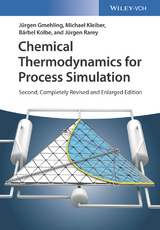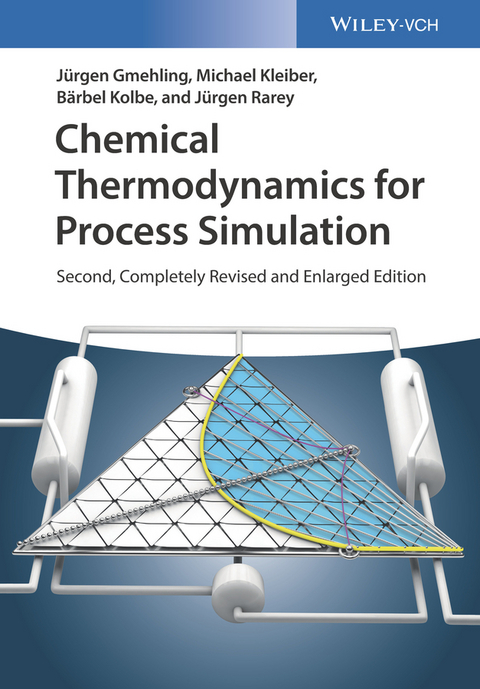Chemical Thermodynamics for Process Simulation
Wiley-VCH (Verlag)
978-3-527-34325-6 (ISBN)
Lese- und Medienproben

The only textbook that applies thermodynamics to real-world process engineering problems.
This must-read for advanced students and professionals alike is the first book to demonstrate how chemical thermodynamics work in the real world by applying them to actual engineering examples. It also discusses the advantages and disadvantages of the particular models and procedures, and explains the most important models that are applied in process industry. All the topics are illustrated with examples that are closely related to practical process simulation problems. At the end of each chapter, additional calculation examples are given to enable readers to extend their comprehension.
Chemical Thermodynamics for Process Simulation instructs on the behavior of fluids for pure fluids, describing the main types of equations of state and their abilities. It discusses the various quantities of interest in process simulation, their correlation, and prediction in detail. Chapters look at the important terms for the description of the thermodynamics of mixtures; the most important models and routes for phase equilibrium calculation; models which are applicable to a wide variety of non-electrolyte systems; membrane processes; polymer thermodynamics; enthalpy of reaction; chemical equilibria, and more.
-Explains thermodynamic fundamentals used in process simulation with solved examples
-Includes new chapters about modern measurement techniques, retrograde condensation, and simultaneous description of chemical equilibrium
-Comprises numerous solved examples, which simplify the understanding of the often complex calculation procedures, and discusses advantages and disadvantages of models and procedures
-Includes estimation methods for thermophysical properties and phase equilibria thermodynamics of alternative separation processes
-Supplemented with MathCAD-sheets and DDBST programs for readers to reproduce the examples
Chemical Thermodynamics for Process Simulation is an ideal resource for those working in the fields of process development, process synthesis, or process optimization, and an excellent book for students in the engineering sciences.
Jürgen Gmehling, PhD, is Professor of Chemical Engineering at the University of Oldenburg, Germany. He is also president and CEO of DDBST GmbH, Oldenburg, as well as cofounder of LTP GmbH, part of the Carl von Ossietzky University of Oldenburg.
Michael Kleiber, PhD, works as a Chief Development Engineer for ThyssenKrupp Uhde, Germany.
Bärbel Kolbe, PhD, is a senior process engineer for ThyssenKrupp Uhde, Germany.
Jürgen Rarey, PhD, is a professor at the University of Oldenburg, Germany, and cofounded DDBST GmbH, Oldenburg. He is also an honorary professor in Durban, South Africa.
INTRODUCTION
PVT BEHAVIOR OF PURE COMPONENTS
CORRELATION AND ESTIMATION OF PURE COMPONENT PROPERTIES
PROPERTIES OF MIXTURES
PHASE EQUILIBRIA IN FLUID SYSTEMS
CALORIC PROPERTIES
ELECTROLYTE SOLUTIONS
SOLID-LIQUID EQUILIBRIA
MEMBRANE PROCESSES
POLYMER THERMODYNAMICS
APPLICATIONS OF THERMODYNAMICS IN SEPARATION
ENTHALPY OF REACTION AND CHEMCIAL EQUILIBRIA
EXAMPLES FOR COMPLEX SYSTEMS
PRACTICAL APPLICATIONS
EXPERIMENTAL DETERMINATION OF PURE COMPONENT AND MIXTURE PROPERTIES
INTRODUCTION TO THE COLLECTION OF EXAMPLE PROBLEMS
APPENDIX A: PURE COMPONENT PARAMETERS
APPENDIX B: COEFFICIENTS FOR HIGH-PRECISION EQUATIONS OF STATE
APPENDIX C: USEFUL DERIVATIONS
APPENDIX D: STANDARD THERMODYNAMIC PROPERTIES FOR SELECTED ELECTROLYTE COMPOUNDS
APPENDIX E: REGRESSION TECHNIQUE FOR PURE COMPONENT DATA
APPENDIX F: REGRESSION TECHNIQUES FOR BINARY PARAMETERS
APPENDIX G: IDEAL GAS HEAT CAPACITY POLYNOMIAL COEFFICIENTS FOR SELECTED COMPOUNDS
APPENDIX H: UNIFAC PARAMETERS
APPENDIX I: MODIFIED UNIFAC PARAMETERS
APPENDIX J: PSRK PARAMETERS
APPENDIX K: VTPR PARAMETERS
| Erscheinungsdatum | 17.04.2019 |
|---|---|
| Verlagsort | Berlin |
| Sprache | englisch |
| Maße | 170 x 244 mm |
| Gewicht | 1554 g |
| Einbandart | kartoniert |
| Themenwelt | Naturwissenschaften ► Chemie ► Physikalische Chemie |
| Naturwissenschaften ► Chemie ► Technische Chemie | |
| Technik | |
| Schlagworte | chemical engineering • chemical thermodynamics • Chemie • Chemische Thermodynamik • Chemische Verfahrenstechnik • Chemistry • Industrial Chemistry • Process Engineering • Prozesssteuerung • Technische u. Industrielle Chemie • Thermodynamik |
| ISBN-10 | 3-527-34325-3 / 3527343253 |
| ISBN-13 | 978-3-527-34325-6 / 9783527343256 |
| Zustand | Neuware |
| Haben Sie eine Frage zum Produkt? |
aus dem Bereich



